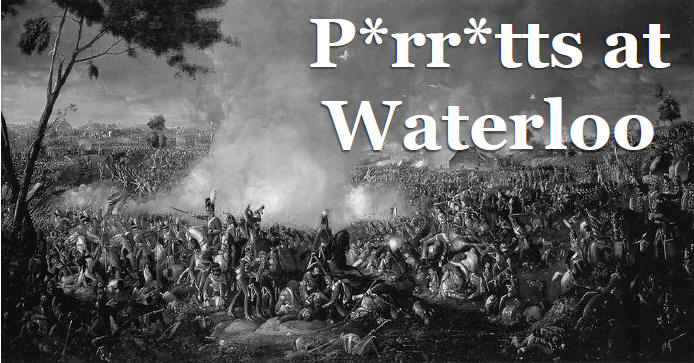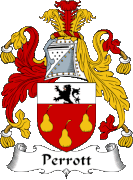
This year marks 200 years since the Battle of Waterloo, which took place on Sunday 18th June 1815. The Duke of Wellington’s British troops – alongside Prussian allies – defeated Napoleon’s army, resulting in the restoration of the French monarchy and Napoleon’s abdication and subsequent exile. A number of P*rr*tt men served in the Napoleonic Wars and several are known to have fought at the Battle of Waterloo.
The names of these men have been taken from the Waterloo Medal Roll, which is available on both the Find My Past and Ancestry websites. Where possible, this has been cross-referenced with British Army records to provide more information. As with any records from this far back in history, the P*rr*tt surname spelling in the records may not exactly match the family name as it is written elsewhere. Thanks must go to David Milner, who has spent a great deal of time compiling information about men who fought at Waterloo and generously shared his research with us.
Do any of these men appear on your family tree? If so, can you tell us anything more about them?
John PARROTT was a private in the 73rd (Highland) Regiment of Foot, 2nd Battalion, in Captain John Pike’s Company. He was born in Surrey and enlisted as a labourer on 5th April 1813, a volunteer from 2nd Royal Surrey Militia. He transferred to 1st Battalion on 4th May 1817 and joined at Trincomalee (Ceylon) on 29th September 1817. John died on 16th December 1818 and left a will in favour of Private R Hardy who received his credit balance of £1 11s 6d.
John PERRETT (Jns PURRETT on Waterloo Medal Roll, John PARRATT in discharge papers) was born in Over Stowey, Somerset in 1776 (son of William Perrett and Mary Hurdle) and worked as a farmer prior to his military service. He enlisted at North Curry in 1803 as a member of the Army Reserve and in 1806 joined the 28th (North Gloucestershire) Regiment of Foot in Captain Henry Moriarty’s Company. He spent 9 days sick in the General Hospital at Brussels and was discharged to a pension on 31st July 1816 on account of a disabled arm from gangrene and dropsy. Records indicate that he was a tanner by trade, 5ft 2ins tall, with brown hair, grey eyes and a brown complexion. John’s father, William, was the late Parish Clerk of Over Stowey and – on his return to the village – John was mentioned in the diaries of the Reverend William Holland (published as ‘Paupers & Pig Killers’): Sunday 3rd November 1816: “The Hero of Waterloo was at Church with his medal and I spoke to him before them all as I came from Church. He is my old Clerk’s son. They say he gives a good account of things” Thursday 25th December 1817: “We had our kitchen full of guests, old Servants &cc and among others the Hero of Waterloo with a Medal, my old Clerk’s son”
James PERRITT was a private at the Battle of Waterloo, serving in 1st Regiment of Foot Guards (or Royal Scots), 3rd Battalion in Captain Thomas Moss’s Company No. 3. James was born in West Calder, Midlothian around 1790. He enlisted in the 1st Regiment of Foot (Royal Scots) in Edinburgh in 1811 and later transferred the 23rd Regiment of Foot. Service records indicate that James Perrett served at the Battle of Waterloo in addition to other engagements, notably the Battle of Salamanca, where he sustained an injury to his right hand. He was awarded the Military General Service Medal with 4 clasps for Salamanca (22nd July 1812), Vittoria (21st June 1813), San Sebastian (9th September 1813) and Nivelle (10th November 1813). James, a labourer by trade, was 5ft 6ins tall with a sallow complexion, long face and dark brown eyes.
William PARROTT (or PARRETT) served in the 10th (or the Prince of Wales’s Own Royal) Regiment of Light Dragoons (Hussars) as a private in Captain Grey’s Troop No. 4. He was Court Marshalled on 13th December 1813 on “suspicion of theft and conduct unbecoming a soldier”. William was sentenced to be flogged with 200 lashes and received 140. He later received the Military General Service Medal with 3 clasps for service at Vittoria (21st June 1813), Orthes (27th February 1814) and Toulouse (10th April 1814). He was wounded at Toulouse.
RICHARD PARROT was a Corporal in the 1st (or Royal) Regiment of Dragoons. He was recruited at Tewkesbury and served at the Battle of Waterloo.
John PARROTT served in the 51st (2nd Yorkshire West Riding) Regiment of Foot (Light Infantry) as a private in Captain Samuel Bearly’s Company. Pay list shows he was in receipt of an enhanced rate of pay for 7+ years or service, which means he must have enlisted in 1808 or earlier. He was a labourer prior to enlistment and was born in Bandon, County Cork. John is recorded as “sick absent, General Hospital 37 days” after Waterloo, indicating that he must have been wounded. He was discharged to a pension on 25th February 1819 on reduction of the Regiment at the age of 34 years.
William PARROTT was a Private in the 40th (or 2nd Somersetshire) Regiment of Foot, 1st Battalion. The pay list shows that he was in receipt of an enhanced rate of pay for 7+ years service, indicating enlistment in 1808 or earlier. He is recorded as having been left – sick – in the Peninsula.
Richard PARRETT (or PARROTT) served as a Private in the 1st Regiment of Foot Guards (later Grenadier Guards), 3rd Battalion, in Lieutenant Colonel Reeve’s Company at the Battle of Waterloo. He was born in Hornsey and enlisted as a labourer at Athlone on 4th May 1812, a volunteer from West Middlesex Militia. He was 5ft 8ins tall, with hazel eyes and a dark complexion.
Elijah PARRATT is named on the Waterloo Medal Roll serving as a private in the 44th (East Essex) Regiment of Foot in Captain David Power’s Company. He died in January 1816.
